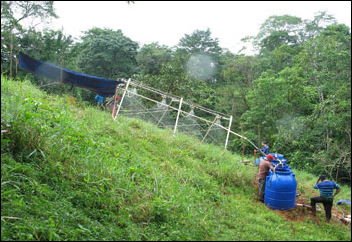Source: Water Resources Research
In humid tropical forests, intense biological activity shapes the ground below. Tree roots and earthworms carve paths through the soil that are followed by rainwater, some of which eventually flows into deep groundwater reservoirs. The influence of roots and earthworms has been difficult to quantify.
Now a new study by Cheng et al. harnesses advances in soil imaging techniques along with simulated rainfall tests using an actual motorized sprinkler system to improve simulation of water flow in the soils of tropical forests. They used previously collected data on the effects of tree roots and earthworms to develop four water flow models of varying complexity and tested them against real-world water flow observations.
Each of the four models incorporated the fact that tree roots carve horizontal paths and earthworms carve vertical paths through shallow soils. On the basis of observational data, two models divided shallow soils into distinct layers, with horizontal paths dominating the upper layer and vertical paths dominating the lower layer. One of these two-layer models also simulated intersecting earthworm burrows.

The researchers used rainfall data collected between February and October 2012 from a steep-sloped tropical forest site in the Panama Canal watershed that has been extensively studied as part of the Smithsonian Tropical Research Institute’s Agua Salud Project. They then compared the predictions of the model simulations to real-world hydrological, geophysical, and geochemical data from several sources.
The researchers found that the two models that divided shallow soils into two layers returned more accurate predictions of runoff, groundwater discharge, and other variables than the simpler models. The model that incorporated details of earthworm burrows performed best.
These findings demonstrate that using observational data to accurately incorporate horizontal and vertical flow paths can improve soil water flow models. The authors suggest that in future work, model parameters could be improved to evaluate potential effects of different land use management decisions on water flow. (Water Resources Research, https://doi.org/10.1002/2016WR020258, 2017)
—Sarah Stanley, Freelance Writer
Citation:
Stanley, S. (2017), Follow earthworm tracks to better simulate water flow in soils, Eos, 98, https://doi.org/10.1029/2017EO078625. Published on 01 August 2017.
Text © 2017. The authors. CC BY-NC-ND 3.0
Except where otherwise noted, images are subject to copyright. Any reuse without express permission from the copyright owner is prohibited.

